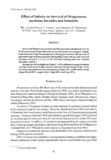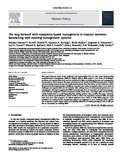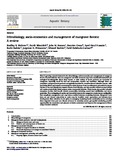Search
Now showing items 41-50 of 59
Mangroves and brackishwater pond culture in the Philippines
(Springer Verlag, 1995)
Around 50% of mangrove loss in the Philippines can be traced to brackishwater pond construction. The decrease in mangroves from 450 000 ha in 1920 to 132 500 ha in 1990 has been accompanied by expansion of culture ponds ...
Effect of salinity on survival of Metapenaeus anchistus juveniles and subadults
(University of the Philippines in the Visayas, 1997)
Survival of Metapenaeus anchistus (De Man) juveniles and subadults at 5, 15, 25, 35 (control) and 45 ppt salinity levels was determined and compared. Salinity levels lower than 35 ppt level were prepared by diluting pure ...
Development and conservation of Philippine mangroves: institutional issues
(Elsevier, 2000)
The decline of Philippine mangroves from half a million hectares in 1918 to only 120 000 ha in 1994 may be traced to local exploitation for fuelwood and conversion to agriculture, salt beds, industry and settlements. But ...
Are mangroves worth replanting? The direct economic benefits of a community-based reforestation project
(Cambridge University Press, 2006)
Competition for coastal land use and overexploitation have reduced or degraded mangrove coverage throughout much of their distribution, especially in South-east Asia. Timber production was the initial motivation for early ...
The way forward with ecosystem-based management in tropical contexts: Reconciling with existing management systems
(Elsevier, 2012)
This paper discusses some of the challenges and opportunities that can arise when implementing ecosystem-basedmanagement (EBM) in tropical nations. EBM creates a new series of challenges, problems, and opportunities that ...
Ethnobiology, socio-economics and management of mangrove forests: A review
(Elsevier, 2008)
There is growing research interest in the ethnobiology, socio-economics and management of mangrove forests. Coastal residents who use mangroves and their resources may have considerable botanical and ecological knowledgeable ...
Preliminary results of feeding aquatic macrophytes to Penaeus monodon juveniles
(Elsevier, 1989)
Penaeus monodon juveniles (PL<sub>50</sub>) were fed live and decaying aquatic macrophytes and a commercial grow-out pellet (40% crude protein) in 80-l glass tanks over a 30-day period. Growth and survival were significantly ...
A review of mangrove rehabilitation in the Philippines: successes, failures and future prospects
(Springer, 2008)
From half a million hectares at the turn of the century, Philippine mangroves have declined to only 120,000 ha while fish/shrimp culture ponds have increased to 232,000 ha. Mangrove replanting programs have thus been ...
Seasonal abundance, distribution and recruitment of mud crabs (Scylla spp.) in replanted mangroves
(Elsevier, 2006)
The abundance and distribution of mud crabs were studied in a replanted mangrove forest in Buswang, Aklan, Philippines. Two fishing gears, lift nets and bamboo traps, were used to monitor relative abundance of Scylla spp. ...
Effect of different mangrove-to-pond area ratios on influent water quality and WSSV occurrence in Penaeus monodon semi-intensive farms using the greenwater culture technique
(Elsevier, 2012)
White spot syndrome virus (WSSV) has been affecting the shrimp industry worldwide for two decades now. It continues to bring economic losses to affected farms. Despite the many studies on its epidemiology, there is no ...











